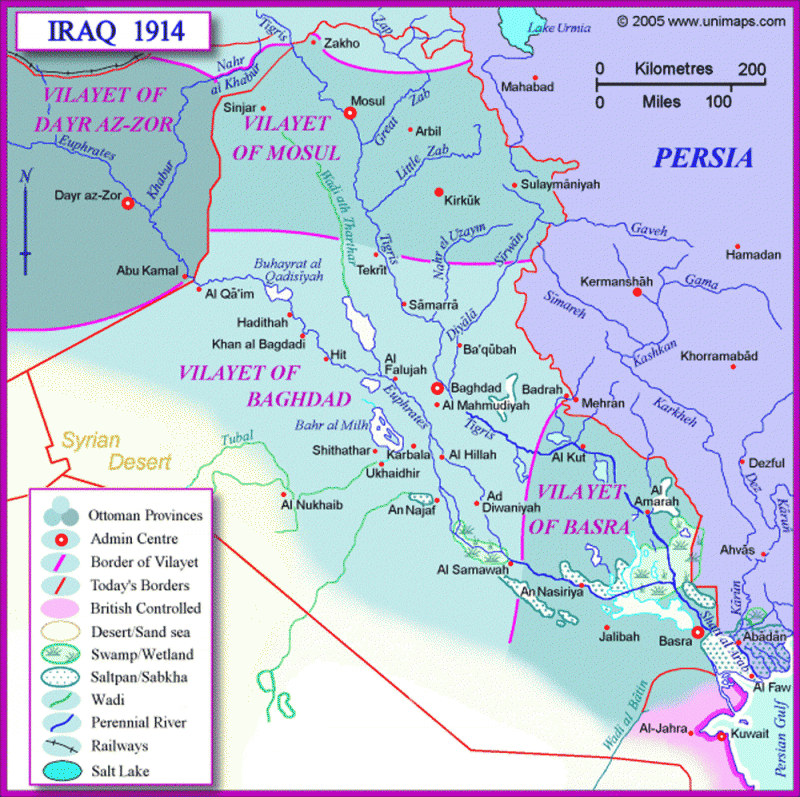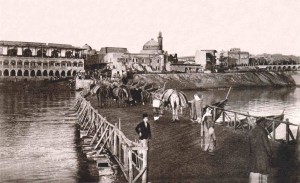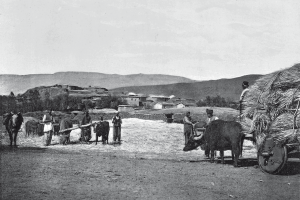Shared Sorrows: Indians and Armenians in the prison camps of Ras al-‘Ain, 1916-18 – 6.
[Below is a map of the region referred to in this and the last few posts, with the boundaries of the administrative divisions (vilayet) of the Ottoman Empire marked.]

To return to On to Baghdad: on August 25, when Sisir Sarbadhikari and his fellow POWs reached Mosul they still did not know where they were being taken.

It was in Mosul that they received word of their destination: the Hindus (and Sikhs) were to be separated from the British and Muslim POWs; they would be sent to Ras al-‘Ain, where they would work on a rail line. (p. 124)[i]
Although Sisir does not make much of it, there is something distinctive about his use of the word ‘Hindu’ here. The word does not occur often in the text, and until this point in the narrative, it has never been used to suggest that the various different non-Muslim groups in the British Indian expeditionary force had felt themselves to be ‘alike’, and different from their fellow soldiers. Sisir’s use of it in this sense here suggests to me that he and his comrades were surprised and disturbed to learn that the POWs from the British-Indian 6th Division, who had served together on the battlefield, were now to be split up along religious as well as racial lines.[ii] Many of them would probably have concluded that Hindus and Sikhs, being neither Europeans nor co-religionists of the Turks, would have to endure the worst conditions.[iii] Their apprehensions would surely have deepened when they learnt that they were being dispatched to an area where thousands of Armenians had been confined in concentration camps. The sense of being singled out for a shared plight probably contributed to the bonds of sympathy that developed between these Indians and the Armenians they encountered.
From Mosul the prisoners marched to Tell Kaaf.[iv] Shortly after this they entered a markedly different landscape:
‘Here everything is beginning to change’[v], writes Sisir, ‘from the climate to the landscape and the appearance of the houses. It’s much cooler than before and the nights are cold. The terrain is no longer flat or undulating, we are now marching through mountainous country; the houses don’t have mud walls and roofs, they are made of stone. Before, there were no trees and no greenery, it was desolate, barren.[vi] Here trees can be seen. Amongst the stone houses, those that are clean, well-kept and nice-looking belong to the Christians (‘Nasrani’)… We are now on the frontiers of Kurdistan.

The Kurds’ villages are mostly perched on mountain-tops, in inaccessible locations. How people can get to them is beyond our reckoning. The Kurds aren’t wanderers like the Bedouin (‘Badu’), they do some farming.’ (pp. 124-5)
Sisir’s first mention of Armenians comes a few days later, on August 18th. In the course of that day’s march the prisoners encountered two rosy-cheeked Armenian boys, eight to ten years old. Sisir notes that they had crucifixes on their chests. ‘From what they said to us in broken Arabic,’ he writes, ‘we understood that the Turks had slaughtered their father and older brothers; where their mother was they did not know.’ (p. 126)

On the 23rd of August, the prisoners came to a small village. ‘From a distance the small stone houses, cradled by the mountains, were as pretty as a picture.
On approaching closer we saw that they were empty of people. A dog emerged from an abandoned house… At that time we didn’t know that the inhabitants of these villages were Armenians; the men had been slaughtered and the women and children had been driven away.’ (p. 129)
Sisir’s description of the village is accompanied by a few lines from Oliver Goldsmith’s poem ‘The Deserted Village’ (quoted in English):
Along thy glades, a solitary guest…
Amidst thy bowers, the tyrant’s hand is seen,
And desolation saddens all thy green. (129)’
[i] Cf. Heather Jones, (op. cit.) suggests that the separation of prisoners happened at Ras al-‘Ain: ‘Non-Muslim other rank Indian prisoners were eventually segregated at Ras-el-Ain to work on the railway line; Muslim and British other rank prisoners were transported on from Ras-el-Ain by train to separate camps in Turkey proper.’ But Sarbadhikari’s account suggests that it happened earlier.
[ii] The term ‘Hindu’ was perhaps more relevant to the British army’s administrative practices than to the conceptions of the soldiers themselves. In dividing the Indian soldiers by religion the Turks were possibly following British practices.
[iii] It is generally agreed that Indian Muslim troops were better treated by the Ottomans; whether this was true of British troops is not clear. For a full discussion of this issue see Heather Jones op. cit.
[iv] Vedica Kant, an Indian research scholar in Turkey, suggests that this was probably a small town to the north of Mosul. I am very grateful to Vedica for looking up place names, and for providing translations of some of the Turkish words that occur in the text.
[v] The 19th century English traveler J.S. Buckingham, also remarks on the distinctiveness of this general region and its inhabitants, Travels in Mesopotamia, London 1827 (204-5).
[vi] Sisir uses the English word. Here and elsewhere I have italicized words from the text that were of particular interest to me.
